A Tale of two Eminent Contemporary Men
This is a brief story of two eminent men : Mr HS Malik (1894-1985) and Bhai Hira Singh ji (1889-1926) They both became well known and left an indelible mark on the sands of time. Their fields activity were very different, but they had one thing in common: their vision was high above the clouds, and therefore, they could look far beyond others. And yet, they were able to keep their feet firmly on the ‘terra firma’. As Kipling has said, “they could walk with the Kings, and yet not lose the common touch”. The younger of the two lived twice as long as the older person, and has recounted his memories of meeting the saintly Bhai Sahib. Their life stories inspire awe, and have a couple of things to teach, and therefore, we thought it fit to post them on this blog.
Part One : Mr HS Malik, ICS and Diplomat
Malik was born on 23 Nov 1894, in a well-to-do family in Rawalpindi. At the young age of fourteen, he sailed off to England for studies, and stayed there from 1908 to 1919. During the war, he joined his British class mates in enlisting for the military. To begin with he served in the French Ambulance but was soon selected to become a fighter pilot. He qualified for a ‘solo’ flight in the shortest possible time and earned his wings. The picture below shows him in uniform. Notice that the dress which was worn by the pilots of that era was quite similar to the cavalry officers ensemble.
HS Malik with his hard earned ‘wings’
During the war, he got into several ‘dog fights’ and is said to have shot down some German planes. However, he was wounded and two bullets got embedded in his legs. After a long period of hospitalization, he returned to his studies. In addition to being a brilliant student, he excelled in sports. He went on to play Cricket for Sussex, and was among the best on the Golf Course all through his long life.
In due course, he appeared for the examination and was admitted into the Indian Civil Service. For the next ten years, he was in the Punjab, caught up in the crossfire between the British Empire and the freedom fighters. For him, it was the toughest period of his service career. After this he did his round of duties in Delhi and England, when he also got an opportunity to go to Germany and see Hitler transforming his country.
He was amongst the first Indians to be sent to the USA, where he was associated with building trade with the Americans. Upon return from there, his services were sought by Maharajah Yadavindra Singh, who wanted him to be his Prime Minister, during the period when it was almost certain that the days of the Princely states were numbered. He gives a graphic account of a meeting of Jinnah with the Sikh Princes, during which Quaid-e-Azam suggested merger of the Sikh states with Pakistan.
When India became independent, Malik was hand picked by Nehru to be the first Indian High Commissioner in Canada to resolve the citizenship issue of the Indians who had migrated as farmers and builders. This was followed by another diplomatic assignment. He was sent as the Indian Ambassador to France. By that time, he had matured, and here is what he looked like:
The Diplomat HS Malik
Upon retirement from the Civil Services, he turned to his first love: Golf. To keep himself occupied, he did continue to be a Director with some corporate companies, but the Greens and the Fairways were his real passion. In 1973, on his 79th birthday, he shot an incredible 79 on the Delhi Golf Course. Here his a picture that shows him taking a strike:
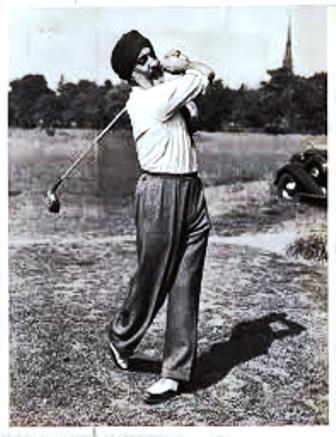 HS Malik, the ‘Golf Addict’
HS Malik, the ‘Golf Addict’
“A Little Work; A Little Play”
When his children and friends coerced him, he did sit down and recorded his autobiography. And in his own humble way, he gave it a title which seems to suggest that what he had done was just a little bit of everything! When one goes through its pages, it becomes clear that he took his joys and sorrows lightly. Responsibility never weighed heavy on his shoulders. He took the most contentious decision with a smile on his lips. He served his English masters with the same professional zeal, which he displayed when the Indians took over the reins. All through his life, his feet were firmly on the ground. His hook teaches us how to live a life full of struggle and turmoil; and yet, remain unruffled. Here is the title of his book:
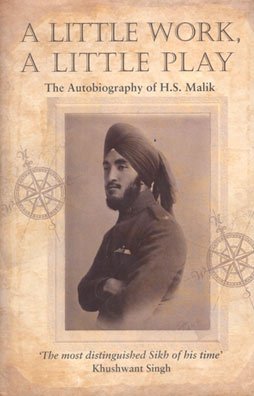 “Bazeecha-e-atfaal hai, duniya mere aage” said Ghalib. And Malik lived that way.
“Bazeecha-e-atfaal hai, duniya mere aage” said Ghalib. And Malik lived that way.
Part Two : Bhai Hira Singh ji. A Singer of Hymns
In sharp contrast with Malik Sahib, Bhai Hira Singh ji was a ‘ragi ( a singer of hymns) His date of birth is not known, but in all probability he was born in 1879 in a small village called Faruka District Sargodha, now in Pakistan) He received very little formal education, and as per the tradition of that period, he was married to a very charming girl at the age of 15. However he was not cut out for a prosaic rural life. After a few years, he left home and joined the entourage of a Saintly preacher. With his mentor, he travelled far and wide. In those days, when trains were at a rudimentary stage he went as far as Nanded (Maharashtra) where he is said to have received the blessings of the Guru. Upon his return to Amritsar, he began what later turned out to be a missionary life. Recognition and fame came soon. By the time he was in his early twenties, he had acquired the looks of a visionary. He had learnt up a great deal of ‘gurbani’ and he could enrapture his audience with his melodious rendering. The picture below was taken in 1903. The radiance on his face is quite evident.
Bhai Hira Singh ji 1903. Notice the pious look in his eyes and the musical instrument in his hand. He was about 24 years od then.
From here began a journey, which made a difference in the lives of masses. His was a short life. We have a graphic account of how he died at the age of 47 on 2nd September 1926. However, within these twenty odd years he was able to leave an indelible mark on the sands of time. Highest on the list of priorities was a School in the place of his birth. A small school was established in 1906, which was upgraded to a High School in 1908. People of all communities contributed in this project, and we are told that it is still running there in Farooka. However, since many members of the staff migrated to India in 1947, it was re-established in Ambala Cantt. A picture of the School is given below:
Farooka School, in its new location in Ambala Cantt
As one enters the portals of this institution, one sees a tablet which is derived from the stone in the school in Farooka.
Picture of the tablet at the entrance of the school in Ambala Cantt
His life and events are extensively covered in the news papers of that period. Special issues were published soon after his untimely demise in 1926. Based on these, the eminent Poet, Bhai Vir Singh ji suggested that his biography should be published. To begin with a small book was published by an Amritsar based organization. Later, a more detailed anthology was compiled and edited by Major Balwant Singh ji (1911-2004) which has been re-printed several times.
As one goes through the book, one is struck by the influence which Bhai Hira Singh ji had on the godly persons of other faiths. A most notable example of this is in the well known story of the ‘Sandalwood Whisk’ (Chandan ki Chowr) presented by Haji Mohammed Maskin to the Golden Temple, on 31 Dec 1925. We have it from various records, that Maskin ji attended the kirtan durbar of Bhai Sahib in Gwalior and was so moved by his chanting that he was impelled to gift a precious artefact which he had crafted. We are told that Mohammed Maskin, though born in Lahore had spent most of his long life in Mecca. By vocation a carpenter, he spent the last few years in carving out hair thin strands of sandal wood. It took him five years and seven months to extract 1,45,000 fibers out of more than 350 kilograms of sandalwood to create that amazing artefact, which is bound in a silver handle. The gift was graciously accepted by the Golden Temple and is preserved in the “Toshakhana” (the strong room) It is exhibited to the public along with other precious memorabilia on special occasions. This whisk exudes the sandalwood aroma whenever it is taken out of its glass case. Given below are a few pictures which were published in the newspapers of the period.
Haji Mohammed Maskin with the Sandalwood Whisk. Please note that Muslims also wore turban those days.
We also have a picture of Haji Mohammed Maskin with Bhai Hira Singh and S. Gurbaksh Singh, editor of the paper.
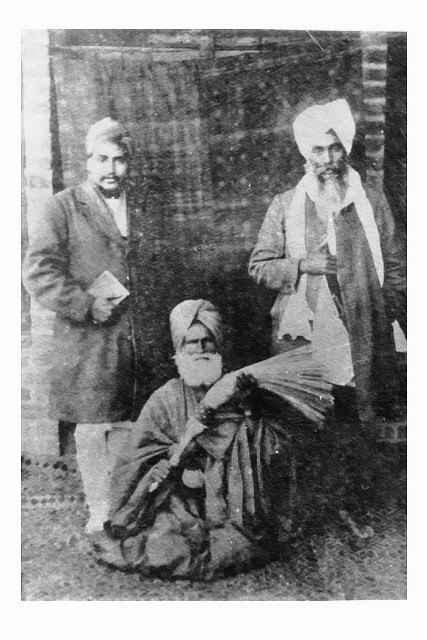 Here, Maskin is sitting and Gurbaksh Singh Narang, the Editor and Bhai Hira Singh ji are standing behind.
Here, Maskin is sitting and Gurbaksh Singh Narang, the Editor and Bhai Hira Singh ji are standing behind.
This is a recent picture of the Sandalwood Whisk. The strands are intact, and it continues to fill the place with fragrance whenever it is taken out of the glass case to be shown to the devotees. The handle is made of silver, which bears an inscription in Urdu which says : “Paanch baras saat mahine mein sandal ke eik lakh panchtalis hazaar baalon ka yeh chaur sakhta Haji Maskin dastkaar ne banaaya aur Shah ki khidmat mein laya gaya”
The Untimely Demise of Bhai Hira Singh ji.
The biography reveals that the cancer in the intestines of Bhai Sahib was diagnosed as early as 1924. However, he continued with his routine of performing Kirtan and addressing gatherings right up to the beginning of 1926. He had his will registered towards the end of 1925, and that reveals that he was fully aware of his impending end. He was no more than forty six years old at that time and had six children, the youngest being merely three years old. However, the words of his final testament do not betray any anxiety or fear. He was more than sanguine that the Lord would take care of his wife and children. He neither had any social security nor pension, and yet, he was certain that the family would never be short of worldly needs. A great deal of the money which came to him for his ‘kirtan’ was given away for social causes, especially the School.
Around a month before his ‘poorna samadhi‘ he requested that treatment be stopped and sought to be moved to a place where large number of people would not throng to meet him, every day. Consequently, he was shifted to a lonely house on the Rajpura Road in Dehradun where he breathed his last in complete peace and tranquillity. Until his last breath, he showed gratitude to the Almighty for all His blessings.
His prophesy came true. His children received adequate education and then they all worked hard to find respectable places in society. Even the trauma of partition failed to disrupt their lives. His son, Maj Balwant Singh edited his latest biography, which has been re-printed several times. Here is what its cover page looks like.
Biography of Bhai Hira Singh. It was first published in 1981. The current edition came out in 2009
When his life story was being researched, two more events occurred. One, a portrait of Bhai Sahib was installed in the gallery in the Golden Temple in 1975 and a brief sketch of his life was published in the Sikh Encyclopaedia. Here is a picture of the portrait.
 Unveiling of the Portrait of Bhai Hira Singh ji in the Gallery in the Golden Temple
Unveiling of the Portrait of Bhai Hira Singh ji in the Gallery in the Golden Temple
A Leaf out of the Biography
I had heard a lot about Mr HS Malik, but got an opportunity to read his autobiography only when our son, Divjyot Singh, Advocate, sent it to me, last month. As I went through his life story, it occurred to me that there was some thing in common between the above two great men. They achieved dizzy heights of fame and glory but forever believed that they were just playing on the sands of time. Later, when I was going through the biography of Bhai Hira Singh, I discovered a piece written by Mr HS Malik on Bhai Sahib. I learnt that, in 1923, Mr Malik was the Deputy Commissioner of Sheikhupura and Nankana Sahib was a part of that district. The Sikhs were at that time engaged in the ‘Gurdwara Reform Movement’ and the tempers were running high. On the occasion of the birth anniversary Guru Nanak Dev ji, Mr Malik was asked to ensure that nothing untoward happened. Bhai Hira Singh ji was traditionally given the unique honour of performing the evening prayer on this solemn occasion for several years. And that year also, he had come. The story as recounted by Mr HS Malik is given below, in his own words.
Crowd Control, Without any Force
By Mr HS Malik, ICS
“I was fortunate, while still a youngster, to listen to the Kirtan performed by Bhai Hira Singh ji and always found it entrancing, because Bhai Hira Singh ji had the gift of taking you entirely out of yourself, into a world of Celestial song and rapture. This, he was able to do, not only because of his knowledge (of the scripture) and skill at the ‘ragas’ but also because of the sweetness of his voice, devotion, complete dedication to his job and his extraordinary humility. This rare combination gave him the power to hold the complete and undivided attention of his audience, while he was performing the kirtan, irrespective of the size of the congregation.
I personally witnessed a most impressive demonstration of this power. In 1923, on the occasion of Guru Nanak Dev ji’s Gurpurab, at the evening Diwan which was being held at the ‘Janam Asthan’ in Nankana Sahib. I happened to be the Deputy Commissioner of Sheikhupura District, and Nankana Sahib was in that District. I was there to see that every thing possible was done to ensure a peaceful celebration of the Gurpurab.
It was a very large congregation, almost a lakh of people. They were spread over the Gurdwara itself, the courtyard around and the roofs of the buildings around. Also, since there were many children with the young mothers, there was a lot of noise and confusion. What made the situation particularly difficult to handle was the fact that the entire congregation was spread over such a large and sprawling area. The Ragis were seated near the ‘Granth Sahib’. When they started singing, the noise and din was such that even those of us who were sitting close to them could not hear their words. Remember, those were the days, when there were no mikes and loud speakers. There was, therefore complete chaos and those of us who tried to silence the crowd gave it up as a hopeless task.
At this stage Bhai Hira Singh ji appeared on the stage. In his low and melodious voice, he begged the people sitting close to him to become completely silent. This was achieved at once. He then extended the ‘silent’ circle by another ten yards. This process continued until his voice reached even the rooftops. In this way, he achieved complete silence, until, as they say, you could hear a pin drop! The Kirtan proceeded for more than an hour, with his vast congregation spellbound by his magical rendering of the Guru’s words. I can never forget that amazing example of crowd control; not through the force or police, but the sheer sweetness of personality”
(Extract from a letter sent by HS Malik to the Editor of the biography on 28 Sep 1979)
A Tailpiece
My study of great men and women who are worthy of being remembered long after they are gone, reveals that there is a great deal of correlation between their words and deeds. Humility derives out of respect for others. Arrogance and vanity are signs of shallowness. The two men, about whom we have spoken in this piece lived their lives with grace and dignity. Excellence in performance was not delivered to them on a platter. They earned it through sheer dint of perseverance and focus on their goals. And they derived humility out of their unflinching faith in the Almighty. Their unflinching respect for the faith and beliefs of other people is beyond doubt.
To end this post, I am tempted to recount an anecdote out of the life of Bhai Hira Singh ji. We are told that a ‘kirtan durbar‘ was once organized for the exclusive benefit of singers and musicians. The idea was to help them improve the knowledge of the ‘ragas’ by listening to each other. The only other people invited to attend this special session were the connoisseurs of classical music. The ensemble of Bhai Hira Singh ji was one of the twelve odd invitees. They performed all through the evening. At the end, it seems that the performance of Bhai Hira Singh ji was considered the best. He was presented a robe of honour and requested to recite the concluding prayer. When the session ended, many people congratulated him. It seems that for a brief instant, Bhai Sahib experienced a sense of elation. In a moment of weakness, he permitted himself to believe that all the hard work which he had put in, had paid off. The very next moment he was filled with a sense of guilt, because all through his life, he had believed that his singing was a gift of the Lord, and not his own doing. He told the coachman to take him to the Golden Temple, instead of his house. There, he spent several hours, washing the ‘parkarma’ and then drying it with his ‘pallu’ as an act of penance.

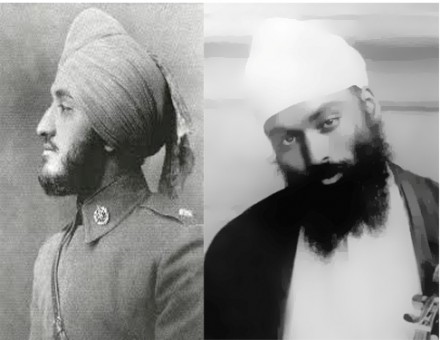


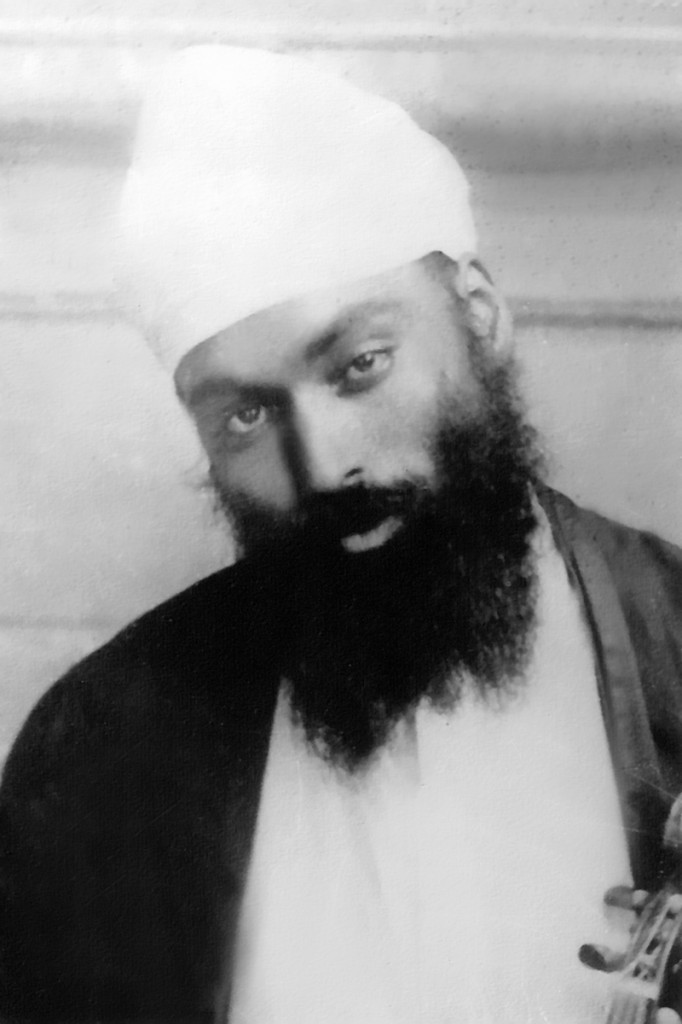
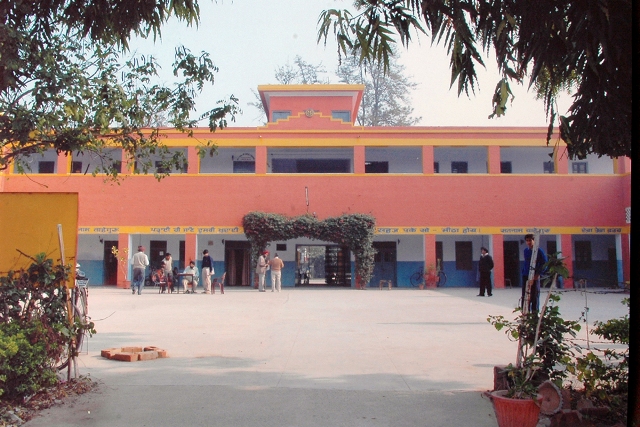
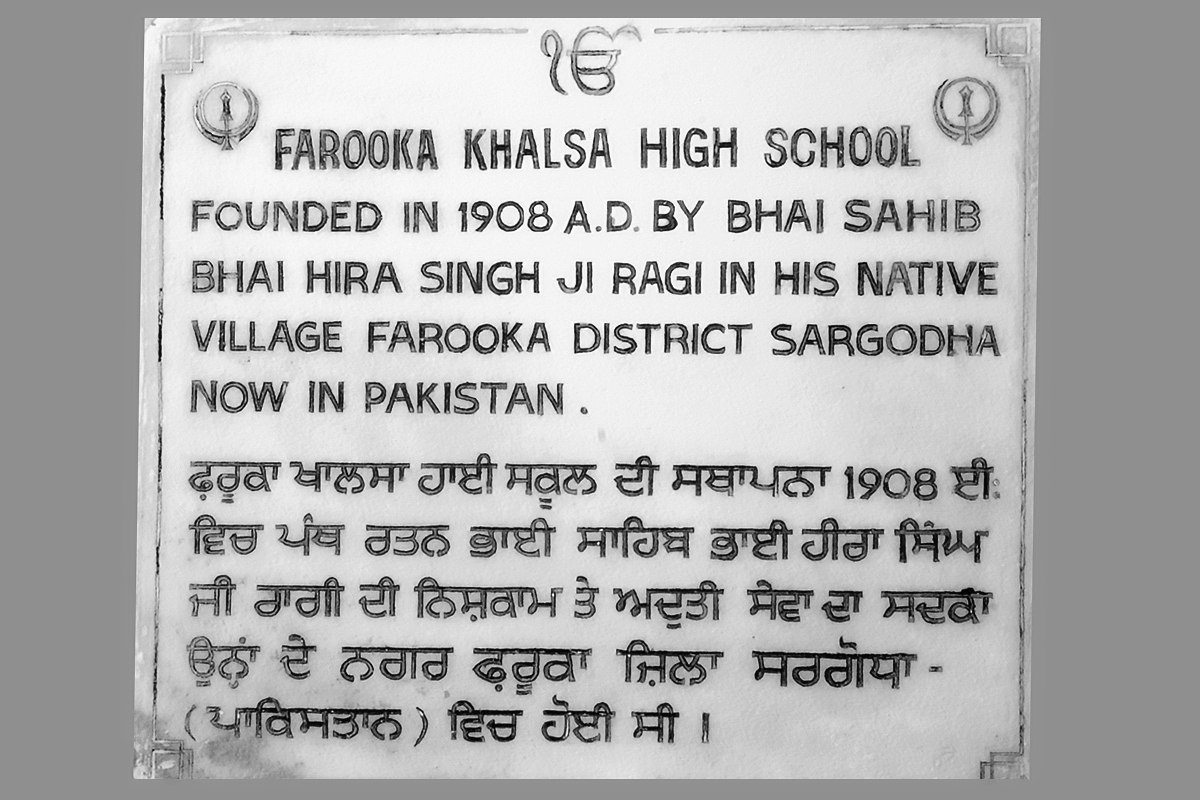
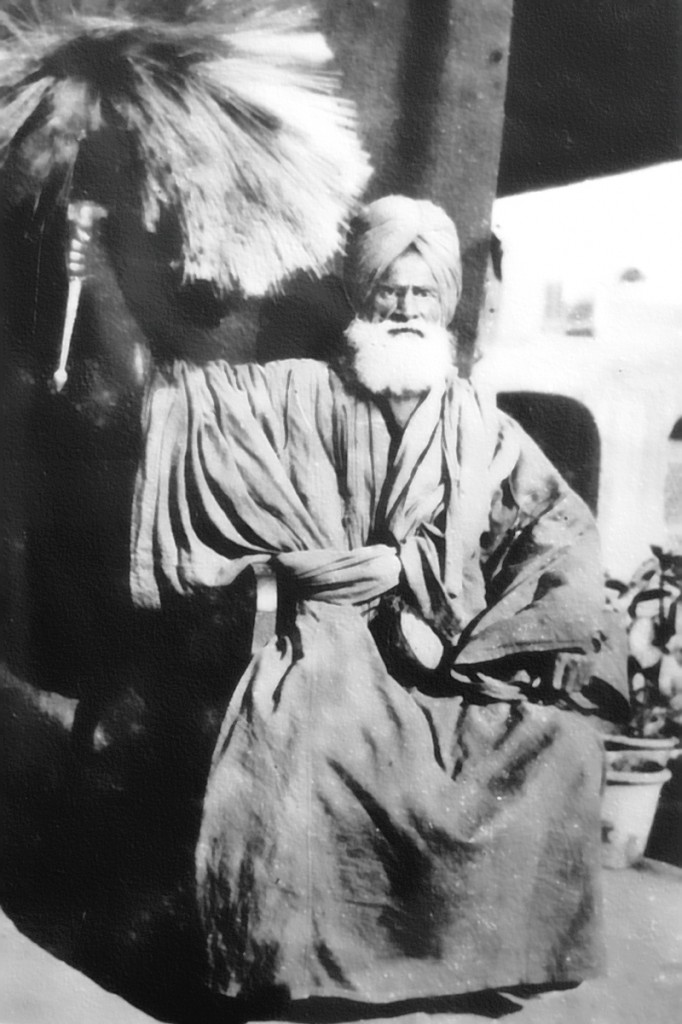
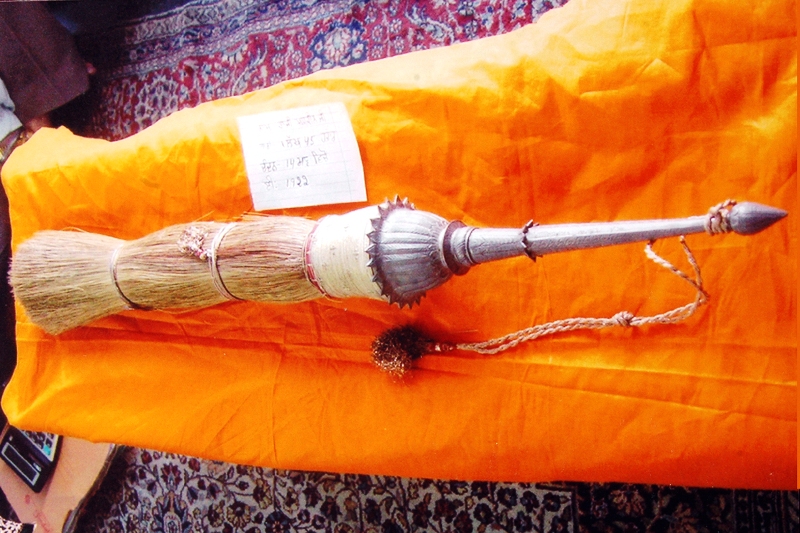





Superb
Dear Gen Surjit Sir,
I really enjoyed reading the two completely contrasting lives of Mr HS Malik, ICS and Bhai Hira Singh ji. Each a great man in his own right who has left “footprints in the sands of time”. Wonderful lives of memorable men.
Regards to Surinder Ma’am and to you.
Jaggi
Sir,
Its indeed a great honour for me to be of some very little help, which you have granted me/blessed me, while i was the CO, Station Wksp, Chandimandir. I can see the same radiance of your great grand fatherji in your eyes too. Sir, I have a request to make pl. Why dont you write your Autobiography for the benefit of people across the world? With profound regards/
Sesh.
Dear Sesha Sai,
Your words are like music to the ears!
I did think of writing the story of my life. But when I took stock of what I have done in my life, I discovered that all my achievements can be written on a postage stamp! (and there may be space left over, still) So I gave it up.
We miss you in Chandimandir. In fact I rarely go there now.
With best wishes for Mrs Sesha Sai and your brilliant children,
Surjit & Surinder
I feel a sense a pride when I think about Bhai Hira Singhji, being part of his clan makes that pride go a bit further. Articles like this and his biography have made him known to ignorants like myself and his biography serves a similar purpose. Most prominent raagi jathas I speak to have heard about him in some form or other and they always have some or the other anecdote to share. I hope his charismatic personality and divine enigma lives through the sands of time via his succeeding generations and his contribution to the overall Sikhi is etched in the Sikh History.
Guru Sahaai.
Regards
Pawan
Dear Pawan Bir,
I endorse your sentiments fully.
There is a lot to learn from the saintly life of this person who was able to compress so much action in the short span of 47 years granted to him by way of life. How many people think of establishing a school in their place of birth at the age of 27?
And that is just one facet of his life. There are many more…
Love. And when are you planning to visit India next? Do spare a few days for us.
Surjit
Thanks sir,
Now, I think, I can trace my geneology to multan-rawalpindi-gujranwala. Maliks of multan.
Sultan
Sultan,
I have no doubt that you will discover some very eminent men and women amongst your ancestors. I think there is a site on the Google, in which you can enter the details which you know, and then the ‘family tree begins to form.
If you have an elderly ancestor, you can ask him to give you some links. Once it begins to form, it expands rapidly.
I know one thing for sure. Col Kohli’s parents are from an eminent family in Dehradun. They owned some cinema halls, and that was a very prestigious thing those days.
Surjit
“Lives of great men all remind us, we can make our lives sublime, and, departing, leave behind us, footprints on the sands of time.” Henry Wordsworth Longfellow – See more at: http://amolak.in/web/eyes-in-the-sky-but-feet-on-the-ground/#comments
Apt lines
I feel sad
having lived all my life with you ….
so ignorantly.
A great man with only humility.
I believe only in those
who are like you
minuscule few
may the Lord
continue to Bless you
Wahe Guru
Sir ji,
Long live the Easy Squadron and the associations it gave me. Frome where else would I have found such earnest well wishers!!!
Surjit
Virji you have done a tremendously good job-remembering bhaiaji in this way.We are really touched.Why Waheguruji din’t give him alittle more time so that we could also have his divine blessings. Waheguru ji unah di yaad saade dillan vich hameshan banai rakhan .
Satinder ji, MP Virji,
When ‘Gul’ writes such kind words, I am tempted to believe that the piece must be readable. And if that be so, then I must try to figure out how it got formed on my computer. And I found the answer. I had nothing to do with it. There are some pictures and paintings on the wall behind my table. Those ancestors descend on my figure and operate the keyboard. Then Microsoft corrects al the spellings. And two friends emerge from nowhere to insert the pictures.
I have no contribution in this whole exercise!
Surjit
I am very glad that GUFTGU will now be available to people on the Facebook. It will thus the hearts and minds of more people, including friends of your friends and beyond. It really deserves to reach farther and farther since you write on such diverse subjects. And so very readable ! GBU .
Dear Brother,
Call me dumb if you like. But the fact is that it took me a long time to work out the full form of GBU! And eventually when I figured it out, I think I saw the Lord standing in front of me and saying “You dumb old man, I think you need my blessings always and every time!”
This Facebook suggestion has come from my friends here, and they are the ones who have implemented it. Personally, I am not capable of such bright ideas.
Surjit
Dear Surjit,
Interesting and Inspiring. Thanks and Regards.
Maj Gen Samay Ram
Dear Samay,
Thanks.
Your words will motivate me to write more such pieces. How else will I hear from friends like you?!
Surjit
Dear Surjit,
Interesting and Inspiring. Thanks and Regards.
Maj Gen Samay Ram
Thank you ,sir for this gem.
PS
Dear Surjit Sir,
I enjoyed reading the write up.There is so much to learn, adopt and act after reading about the two personalities. I am really thankful to you for sending me the mail.
Regards,
Satbir.
Satbir ji,
Your own life is as inspiring as that of the two gentlemen I have talked about!
I always ring you up whenever I feel low. You pep me up, always and every time! May God grant more strength to your elbow!
Surjit
Sir,
Thanks for sharing. Very enlightening.
Regards
Surjit Ji,it must have made you proud to be grand son of Bhai sahib Bhai Hira Singh Ji.In fact I
feel very lucky to be friend of such great man’s grand son.Extremely well written biographic
details.I assure you will be remembered by your writings especially written after retirement .
All the best
Manmohan
Dear Brother,
Yes, indeed. It is a joy to go down memory lane.
I write, because if I do not write, I would not know what to do with myself!
Surjit
Very nice Sir.
Thank you for sharing.
Col Rakesh Sachdeva (Retd)
Pune
Friends,
Maj Gen Surjit Singh, EME has since written an article for you all. Please read it and enjoy.
yash
Thanks, 2997.
It’s an interesting piece. And it’s good that you’ve started a Facebook page.
3007
3007,
This was not my doing. The initiative came from Ashwani who manages my affairs at this end.
It is satisfying to see that more and more friends are joining in this little Blog. You are indeed on top of that list!
2997
Dear Surjit,
Thank you for sending such wonderful mail so enlihgtening about your grand father.You are lucky to be his grand son.
Very kind of you to have included me in the list of lucky ones to be told about him.
I had met Mr Malik a few times & had the honour to play golf with him.
How are things in Chandigarh?
Lots of love.
Amar Jit
2993,
You are in our ‘inner circle’ … a part of our extended family.
Nice of you to fine time to remain in touch with us from ‘across the seven seas’ !
All is well here. We will miss you at the course dinner on the 17th.
No news from Delhi. For them, delay is the best form of keeping us busy!
2997
Thank you sir, for sharing.
Satti Chahal
Dear Sateeshwar,
Good to hear from you. Where are you, and when are we likely to see you next?
Surjit
Sir,
Interesting read but as I mentioned earlier, the multiple fonts and colours are not pleasing.
Best wishes,
Mahavir
Mahavir ji,
Thanks.
I have modified my style and ensured that I do not use capital letters to emphasize a point. However, my editor believes that use of a soft colour and italics are now being used extensively by many people. I have noted your observation, and keep it in mind. However, permit me to add that no other reader has made this observation, so far.
Regards,
Surjit
Respected sir,
Wonderful History of our ancestors. Like to read such good useful inputs from you.
I had heard a lot about Bhai Hira Singh ji from real nephew of my grandfather ( my grand father was Lala Moti Ram Minocha ji) all from Farookha & Silanwali , on my visit & stay with him during 1959 & 1960 summer holidays in Chandigarh Sector 9. This cousin Chachaji was over 97 age at that time & in great health. His grandsons ( Shri Ram Nath, Sh Ramesh & Sh Ram Prakash Minocha) were the builders of a major set of important Govt. buildings of Chandigarh constructed by them from their own architecture. One of these three had got his Civil Engineering degree from Japan much earlier in 1940s.
With kind & warm regards,
Affectionately Yours,
Satish Manocha, (M) 09448061434, Bengaluru
Satish,
Thanks.
Every time I hear from you, my desire to meet you in person becomes more intense!
You put so much warmth and affection in your words! I think our common heritage makes us feel close to each other.
Regards,
Surjit
Very good quotes indeed.
And so very true. Many thanks Sir.
Yawar Baig
Mirza ji,
Thanks.
You have raised some very pertinent points. I feel as strongly as you do on senseless violence and killing. I suspect neither of us has cogent answers. But I have given this subject a lot of thought, and hope to share my views on the subject some day, Insha Allah!
Surjit
Very informative and inspiring
Ravi,
Thanks.
We are hearing from you after ages! Do give us all your news.
Regards to Mridula ji from both of us.
Surjit
Dear ColonelSaheb, and GeneralSaheb,
The pictures of both Shri H S Malik and Bhai Hira Singhji painted in the piece really moves the readers as both these persons appear to have reached the Spiritual Stage. Both were Saints and we need to bow in front of them for their ‘करतूत. In Marathi we have a saying, “बोले तैसा चाले त्याची वंदावी पाऊले”. Both deserve this status. I really appreciate Generalsaheb for his efforts to acquaint us, ignorant people with these worthy and pious personalities.
With regards,
——Mukund Apte
Dear Mukund,
Thanks.
While at the Academy in Kharakwasla, I picked up a bit of Marathi, and can comprehend the meaning of the proverb.
You have hit the nail on the head!
Regards,
Surjit
PS
Are you, in any way related to Lt Gen SS (Bapu) Apte? We hold him in very high esteem
Thomas,
Thanks. You have made up for your absence on this blog (which is as much yours as mine) by being the first to respond to this post!
The more I think of life, the more I am convinced that students who work unduly hard to attain good marks are ill-advised. And the same goes for those who adopt unfair means to gather wealth and recognition.
Means are more important than the ends. I am more convinced on this than ever before.
Welcome back home. ‘East or West, home is the best!’
Surjit
It is difficult to find words that can express my emotions when I read this piece.
The stories are well known in our family right from childhood but still they create
resonance in my mind.
The grand childern of Bhai Hira Singhs grand childern are still in their formative
years. These memories will be deeply imprinted on their minds and will
certainly mould their personality. The books written by our father Maj Balwant
Singh will continue to inspire many more generations.
ensure
Dear Surinder,
Thanks.
There is nothing new in this post…How can the history change?
But then, every time I read the book, I find something that I had not observed before. You, Virji and I owe it to the posterity to record our experiences for the benefit of the coming generations. Let us do what we can.
Your mail appears to be incomplete.
Surjit
PS
Kindly go through the post again. I have added two pictures and some text.
An excellent article ! So inspiring !! Thank you, Surjit .
An excellent article ! So inspiring !! Thank you, Surjit .
Brother,
Your comments are more inspiring than the post!
I have said nothing new; as observed by Surinder.
Surjit
Once again I am reading pieces on two Heroes that I knew very little about.
I had heard and seen H S Malik at Delhi. Whenever he entered the Club, all tables will tell you that he is HS Malik ICS. Never met him.
Indeed they led a different but brilliant life for the country and community.
Thanks for sharing,
Dave Sood
Dave,
Thanks.
Yes, indeed. The two men described above lived and performed their duties during a difficult period. Their inner loyalty was to their fellow Indians, and they had to abide by their colonial masters, even when they were unfair.
And then in 1947, they had to switch their loyalties, almost overnight!
But they achieved that too. In case of HS Malik, it was simple: he treated life like a game. And he did not take it unduly seriously. Golf course is an excellent place to release tension. One senior officer told me once,
“While teeing off, as you address the ball, just think that the ball is the head of your adversary. You will gain in two ways. The ball will go far…and you will feel lighter!”
Regards,
Surjit
Truly sublime and thought-provoking. Profound message lucidly recounted through these fascinating case-studies of greatness in simplicity and solemnity
Sir,
Thanks.
You have put your finger at the right place. Simplicity is more important than every thing else.
Sir, I also believe that those of us who get an opportunity to see life at a higher platform owe it to the posterity to recount our experiences…and just leave them there. No need to push them down the unwilling minds to read or comprehend.
Regards,
Surjit
“Lives of great men all remind us, we can make our lives sublime, and, departing, leave behind us, footprints on the sands of time.” Henry Wadsworth Longfellow
HS Malik has always been an inspiration for all aviators of the Indian Air Force. And Bhai Hira Singh has inspired several generations who followed him.